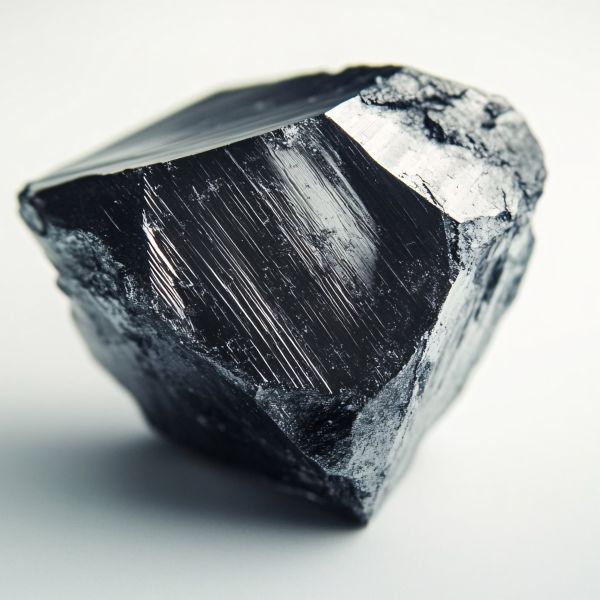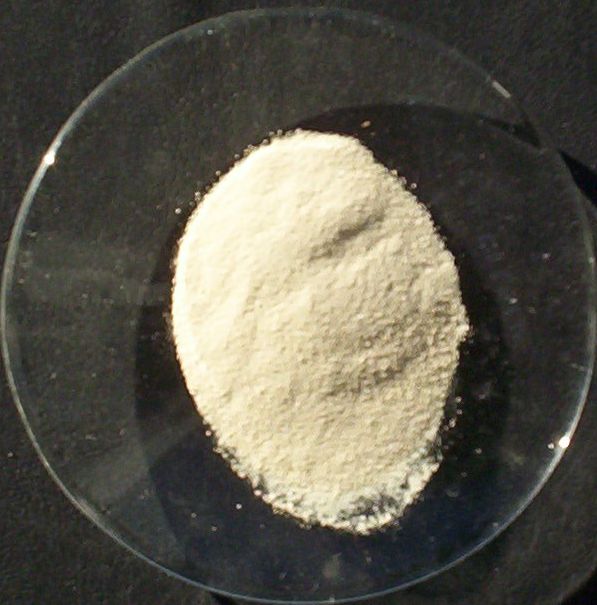Cerium • Ce • Atomic Number 58

Cerium
Cerium is a silvery-gray, relatively soft, ductile, paramagnetic, and reactive metal. It is the most abundant lanthanide and occurs about as frequently as copper. Cerium belongs to the group of light rare earth elements.
In 1803, Swedish chemists Jöns Jacob Berzelius and Wilhelm Hisinger discovered the element. Independently, it was also discovered around the same time by German chemist Martin Klaproth. It was named after the dwarf planet Ceres, which had been discovered shortly before.
Like most rare earth elements, cerium was first identified in the form of its oxide — cerium dioxide (cerium(IV) oxide) — and only decades later isolated as a pure metal.
In the second half of the 19th century, Carl Auer von Welsbach successfully developed two products that required the use of cerium: gas mantles and ferrocerium (lighter flints). Auer's gas mantles enabled gas lamps to emit a bright, white light.
As with other rare earth elements, cerium is never found in its pure form in nature. It is extracted from minerals such as xenotime, monazite, and bastnäsite, or from ion-adsorption clays.
Rare Earth Elements

Cerium is primarily extracted from cerium-containing monazite and bastnäsite. It also occurs in allanite, zircon, samarskite, and the titanium mineral perovskite. Major producers include the United States, China, Russia, Australia, and India.
In nature, four stable or extremely long-lived isotopes of cerium occur: stable cerium-140 (88,48 percent) and radioactive cerium-142 (11.08 percent), as well as cerium-138 (0,25 percent) and cerium-136 (0,19 percent). Excluding nuclear isomers, a total of 38 radioactive isotopes of cerium have been identified. Their mass numbers range from 119 to 157, with half-lives varying from just 1,02 seconds for cerium-151 to 5 × 10¹⁶ years for cerium-142.

Cerium metal is produced by electrolysis and metallothermic reduction of its halides using alkali or alkaline earth metals. It exists in four allotropic (structural) forms. The α-phase is face-centered cubic (FCC) with a = 4.85 Å at 77 K (−196 °C or −321 °F). The β-phase forms just below room temperature and is double hexagonally close-packed (DHCP) with a = 3.6810 Å and c = 11.857 Å. The γ-phase is the room temperature form and is face-centered cubic (FCC) with a = 5.1610 Å at 24 °C (75 °F). The δ-phase is body-centered cubic (BCC) with a = 4,12 Å at 757 °C (1,395 °F).
After an elaborate separation of accompanying rare earth elements, cerium oxide is converted into cerium fluoride using hydrofluoric acid. It is then reduced to metallic cerium by calcium, forming calcium fluoride as a by-product. Remaining calcium and other impurities are removed in an additional vacuum remelting step.
Although rare earth elements are classified as critical raw materials, scarcity does not apply to all of them. As previously mentioned, cerium is the most abundant of the rare earth elements. Since rare earths always occur together in deposits and are extracted collectively, this leads to significant and ongoing overproduction of cerium (and lanthanum, the second most abundant rare earth element).
Despite the demand for cerium and lanthanum, it is nowhere near sufficient to absorb the massive supply generated through mining.
Cerium's ability to switch between the oxidation states Ce³⁺ and Ce⁴⁺ makes it especially useful in catalytic and redox-active processes. Its largest application is in automotive exhaust catalysts. In three-way catalytic converters, cerium oxide is a key component. Another major application is in fluid catalytic cracking (FCC) catalysts used in oil refineries.
Cerium oxide (CeO₂) is also an excellent polishing agent for glass, lenses, and silicon wafers.
In the glass and ceramics industries, cerium is added to glass and glazes to achieve specific properties—such as decolorization by removing impurities in glass and ceramic glazes. This results in clearer glass and purer ceramic finishes. Cerium can also impart a yellow tint to glass, which is used as a UV protection feature.
Cerium continues to be used in lighting applications. In energy-saving lamps, it enhances light quality in fluorescent phosphors. In white LEDs, cerium-doped phosphors (e.g., YAG:Ce) are a key component.
When added in small amounts to aluminum or magnesium alloys, cerium improves their corrosion resistance and mechanical properties.
Cerium-based coatings and conversion layers (e.g., on aluminum or steel) offer excellent corrosion protection and are being researched as more environmentally friendly alternatives to chromate-based coatings.
Cerium dioxide–based materials are used as electrolytes in solid oxide fuel cells (SOFCs) due to their ionic conductivity.
Cerium-rich alloys (e.g., with cobalt or iron) can absorb and release hydrogen and are being studied for hydrogen storage technologies.
Cerium is still used today in lighter flints—a commercial application that dates back to the 19th century, introduced by the enterprising chemist Carl Auer von Welsbach.
The silvery-white, lustrous metal is the second most reactive lanthanide after europium. Superficial damage to its protective yellow oxide layer can ignite the metal. Above 150 °C, it burns with intense glowing to form cerium dioxide. It reacts with water to produce cerium hydroxide.
Cerium occurs in compounds as a trivalent, colorless cation or as a tetravalent, yellow to orange-colored cation.
When exposed to heat, cerium is strongly attacked by ethanol and water. It is also heavily corroded in alkaline solutions, forming cerium hydroxides. In acids, it dissolves to form salts. Because the chemical properties of the rare earth elements are similar, metallic cerium is rarely used in pure form; instead, it is typically employed as part of the mixture obtained during the extraction from rare earth minerals, known as mischmetal.
Like all lanthanides, cerium is slightly toxic. Metallic cerium can ignite at temperatures as low as 65 °C. When finely divided, it can heat up in air without an external energy source and eventually ignite. Its ignition tendency strongly depends on particle size and distribution. Cerium fires must not be extinguished with water, as explosive hydrogen gas would be produced.
Along with praseodymium and terbium, cerium is distinguished from other rare earths by forming compounds in which it exhibits the +4 oxidation state. In solution, it is even the only rare earth element to show a +4 oxidation state. Salts of the Ce⁴⁺ ion (core salts), which are powerful yet stable oxidizing agents, are used in analytical chemistry to determine oxidizable substances such as iron (iron in the +2 oxidation state). Cerium in the +3 oxidation state behaves like a typical rare earth element.
| General Information | |
| Name, Symbol, Atomic Number | Cer, CE, 58 |
| Series | Lanthanides |
| Groupe, Periode, Block | La, 6, f |
| Appearance | silvery-white |
| CAS-Number | 7440-45-1 |
| Mass Fraction in the Earth's Crust | 43ppm |
| Atomic Properties | |
| Atomic Mass | 140,116 u |
| Atomic Radius | 185 pm |
| Covalent Radius | 204 pm |
| Electron Configuration | [Xe] 4f 1 5d 1 6s 2 |
| 1. Ionization Energy | 5,5386(4) eV ≈ 534 KJ/mol |
| 2. Ionization Energy | 10,956(20) eV ≈ 1057 KJ/mol |
| 3. Ionization Energy | 20,1974(25) eV ≈ 1949 KJ/mol |
| 4. Ionization Energy | 36,906(9) eV ≈ 3561 KJ/mol |
| 5. Ionization Energy | 65,55(25) eV ≈ 6320 kJ/mol |
| Physical Properties | |
| State of Matter | solid |
| Crystal Structure | Face-Centered Cubic |
| Density | 6,773 g/cm3 (25 °C) |
| Mohs Hardness | 2,5 |
| Magnetism |
paramagnetic (χm = 1,4 * 10−3) |
| Melting Point | 1068 K (795 °C) |
| Boiling Point | 3743 K (3470 °C) |
| Molar Volume | 20,69 * 10-6 m3/mol |
| Heat of Vaporization | 398 KJ/mol |
| Heat of Fusion | 5,5 KJ/mol |
| Speed of Sound | 2100 m/s bei 293,15 K |
| Electrical Conductivity | 1,35 * 106 S/m |
| Thermal Conductivity | 11 W/(m*K) |

